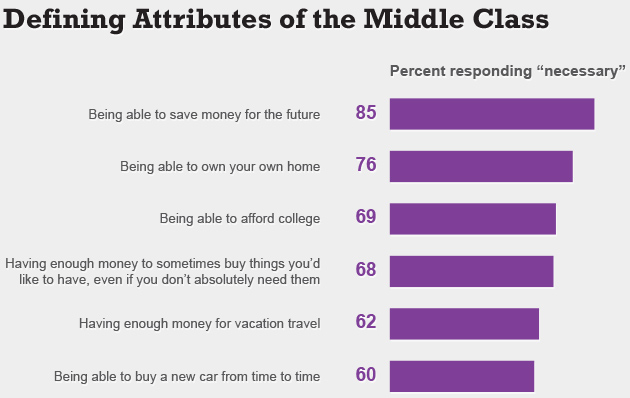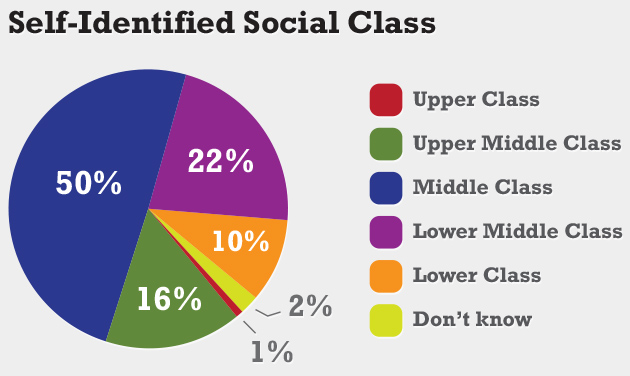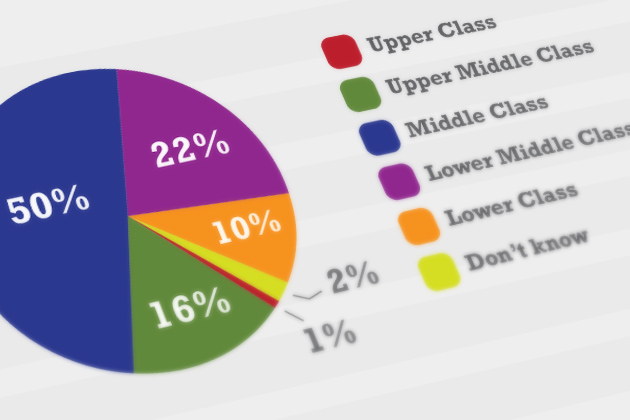
Source: The University of Connecticut/Hartford Courant survey of 1,002 randomly selected adults nationwide, Jan. 22-Jan. 28, 2013.
There is broad agreement among Americans about what constitutes a middle class life, even as those elements – saving for tomorrow, home ownership, a college education, and disposable income for items like vacation and new cars – are increasingly hard to come by, according to a new University of Connecticut/Hartford Courant Poll.
The survey also found that most Americans believe they fit somewhere within the middle class, although there’s disagreement over the level of income it takes to remain there.
“Most people put themselves somewhere in the middle class spectrum, and there’s striking agreement about what it takes to live a middle class lifestyle,” said UConn Poll Director Jennifer Necci Dineen, a faculty member in the Department of Public Policy. “Whether or not that’s easily attainable for everyone who identifies as middle class is another question.”
On the tangible signs of middle class membership, the poll found consensus that cut across lines of age, gender, education level, political party identification, race, and income level:
- 85 percent said saving money for the future is necessary to be middle class
- 76 percent said owning a home is necessary
- 69 percent said affording the costs of a college education is necessary
- 68 percent said it’s necessary to be able to buy things they like, even if they’re not necessities
- 62 percent said having enough money for vacation travel is necessary
- 60 percent said being able to buy a new car from time to time is necessary
While there’s broad agreement on what constitutes a middle class life, since the Great Recession many of those goals have become harder to achieve. The U.S. Census has logged four consecutive years of decline in the median U.S. income, which in 2011 fell to $50,054. At the same time, according to the Federal Reserve, the median household net worth – the value of assets like homes, cars, and any investments minus debt – shrank from $126,400 in 2007 to $77,300, roughly what it was in 1992.
Nor has it been easy to save money – the most commonly cited measurement for a middle class life, according to the poll. The nonpartisan Employee Benefit Research Institute reports that 46 percent of American workers currently have less than $10,000 saved for retirement, and 29 percent have less than $1,000 saved.

Source: The University of Connecticut/Hartford Courant survey of 1,002 randomly selected adults nationwide, Jan. 22-Jan. 28, 2013.
Despite those difficulties, most Americans still say they’re firmly within the middle class. The UConn/Courant Poll found that 50 percent identify themselves that way, with an additional 16 percent calling themselves upper middle class and 22 percent saying they’re in the lower middle class. Just 1 percent of respondents call themselves upper class, while 10 percent say they’re lower class.
Although most people feel they’re in the middle class, they disagree on how much money it takes before a family of four can be considered above the middle class. Nearly a fifth say that earning more than $49,000 puts a family above the middle class, while 30 percent say it takes an income of $79,000, and 36 percent say it requires at least $139,000.
These findings are based on The University of Connecticut/Hartford Courant Poll. The national sample of 1,002 randomly selected adults were interviewed by landline and cellular telephone between Jan. 22 and Jan. 28, 2013. The margin of sampling error for the survey is +/- 3 percentage points for the entire sample, and larger for subgroups.
The data have been weighted by the number of adults in a household and the number of telephone numbers, land and cellular, at which adults in the household can be reached in order to equalize the chances of an individual adult being selected. The data have also been weighted by the sex, race, and level of education of the respondent based on the American Community Survey conducted by the U.S. Census.
The University of Connecticut-Hartford Courant Poll is a joint effort between one of the nation’s top public research universities and the oldest continuously published newspaper in America. The poll’s purpose is to provide unbiased opinion research into critical questions affecting both the state of Connecticut and the nation.
Read additional detail from the survey and analysis of the results.



